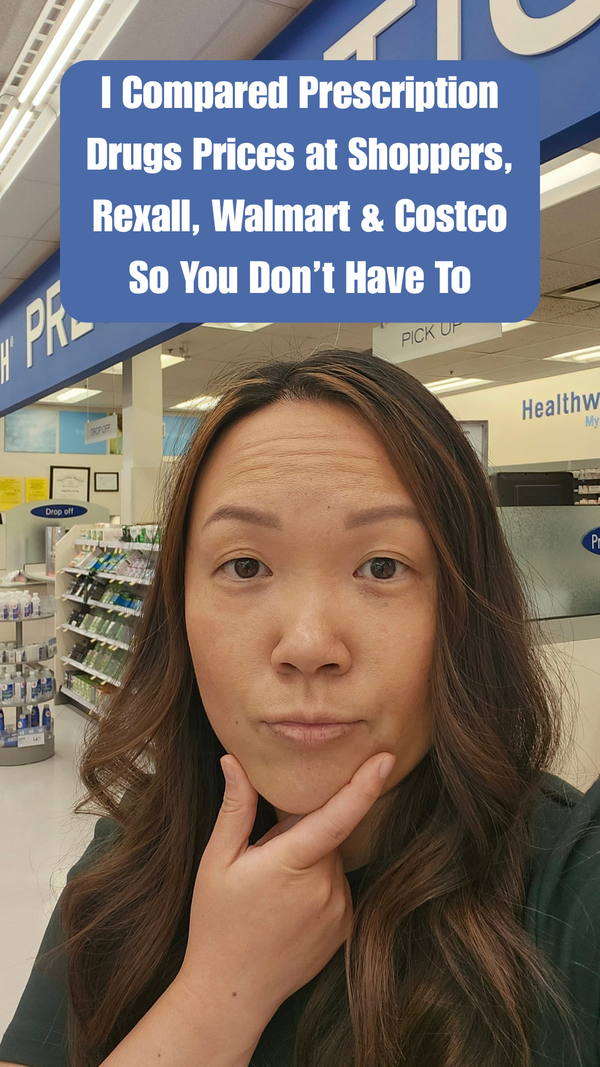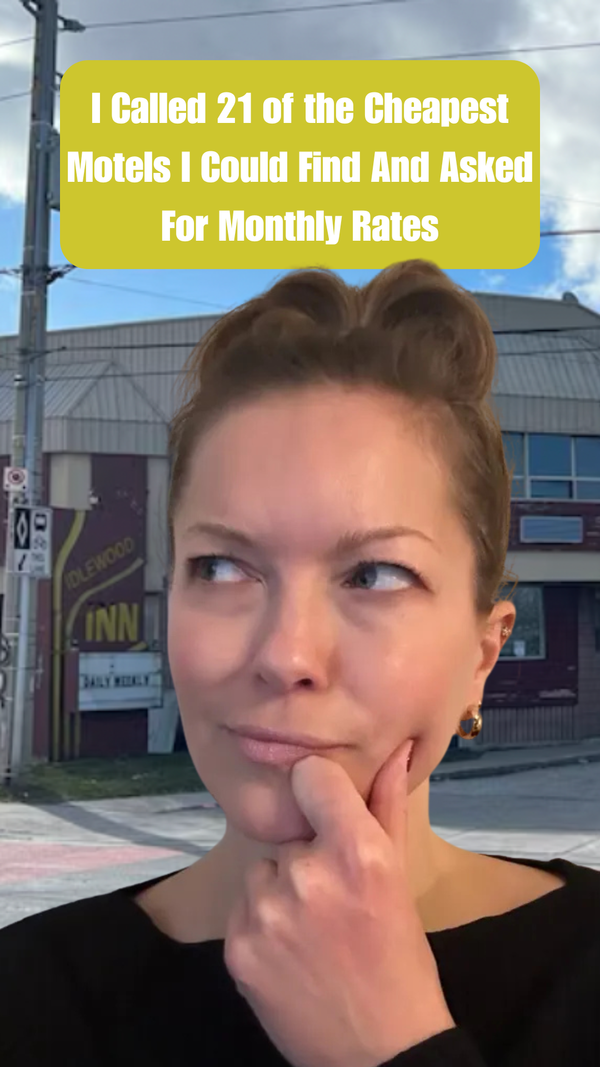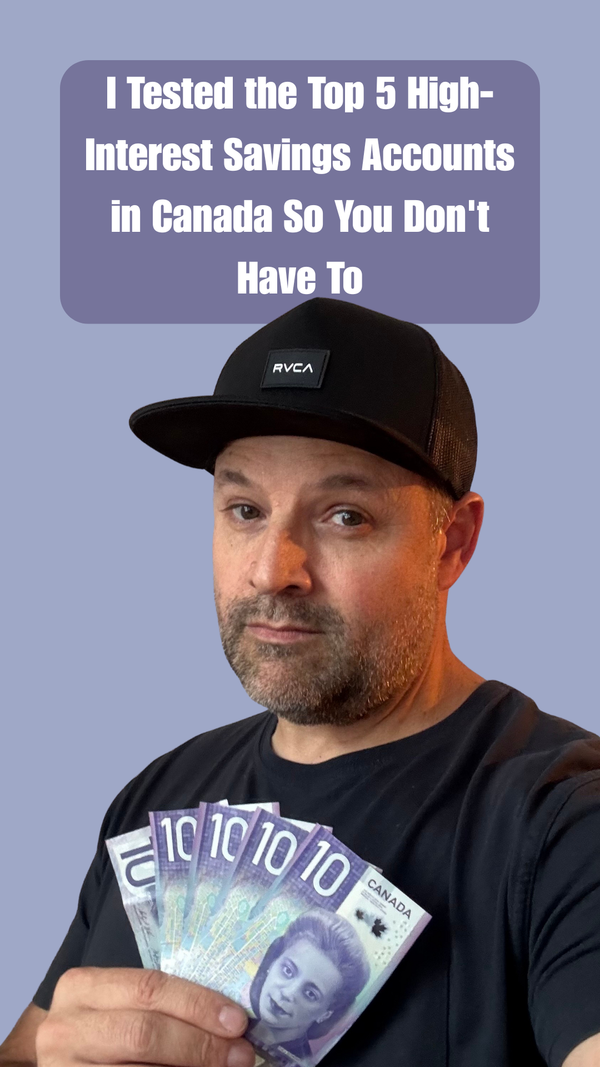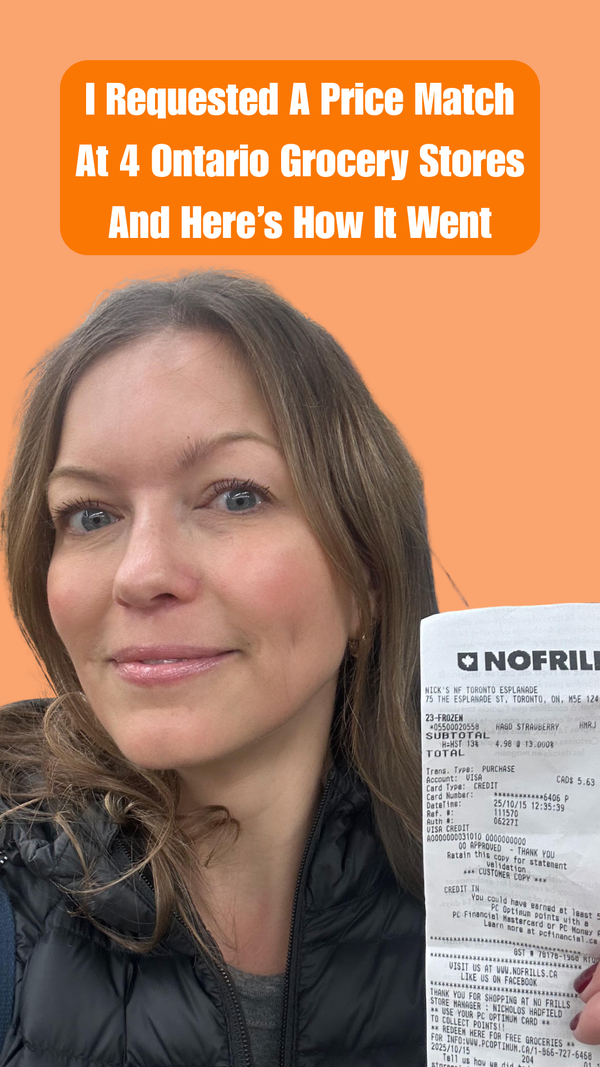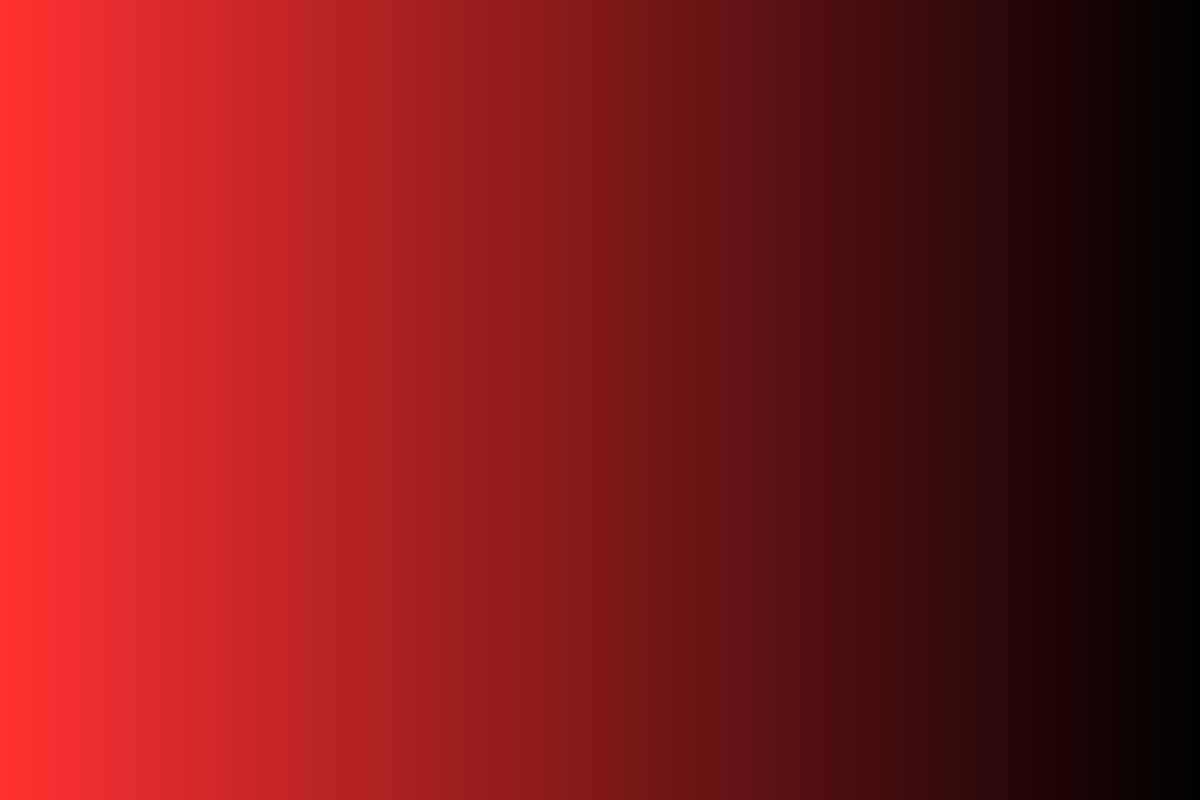Recently, I switched pharmacies because our family moved to a new neighbourhood. Having recently filled a prescription, I was surprised by the price differences between my previous pharmacy and the current one.
So, I started wondering, how do pharmacies set their prices? Are there rules about how much prescription drugs should cost? Are there ways for customers to save money on their medications, particularly when they require ongoing refills?
TL;DR: My thoughts led me to initiate a mini research project, where I compared the prices of the five commonly dispensed drugs in Canada across the four largest pharmacy chains: Costco, Walmart, Rexall, and Shoppers.
Which one came out as the winner? Hands down, the most affordable pharmacy was Costco. If you’re a loyal Costco member, this shouldn’t come as a surprise. The main reason their total drug costs are the lowest compared to their competitors is that their dispensing fee is a jaw-dropping $4.49! That’s right, their dispensing fee was the cheapest amongst the four retail pharmacy chains.
Join me on my journey to understand how drug prices are set in Ontario pharmacies and their impact on customers like you and me.
Why I started looking into prescription drug prices
Although I’m fortunate to have private insurance coverage, these out-of-pocket expenses add up over time. My insurer covers 80% and I pay the remaining 20%. As a result, I was eager to understand how drugs are regulated in Ontario. Additionally, as a finance enthusiast, I’m always seeking ways to optimize our household budget.
But before comparing prices, I needed to understand how drug prices work, and what drug store can and can't do price-wise. To learn from the best in the field, I reached out to a pharmaceutical expert who could break it all down for me.
I spoke with Dr. Mina Tadrous, Associate Professor at the Leslie Dan Faculty of Pharmacy at the University of Toronto. I chose to contact him because of his expertise in drug policy and pharmacy education. He was also highly recommended to me by several doctors in this field.
How is drug pricing regulated in Ontario?
Essentially, the federal government establishes the ceiling prices that drug manufacturers can charge for brand-name drugs nationwide in Canada.
On the other hand, the provincial government sets the maximum drug cost or reimbursement prices for generic drugs under the Ontario Drug Benefit (ODB).
How do pharmacy dispensing fees work?
Pharmacies can add a dispensing fee for each prescription they fill.
So, I then asked Dr. Tadrous why Costco’s dispensing fee is outside of this range and charges only $4.49? He explained to me that some corporations, such as Costco, are willing to lower their prices on dispensing fees to attract more people.
These are the dispensing fees of the pharmacies below:
What's the markup percentage on drugs?
Through my research, I discovered that in Ontario, drugs covered under the ODB have a markup cap of:
- 6% when the total drug cost is equal or greater than $1,000.
- 8% when the total drug cost is less than $1,000.
For drugs covered under ODB, pharmacies must follow regulations and can’t exceed the set maximum drug cost, markup, and dispensing fee.
The exception to the rule is if a prescription is private, meaning that it’s not covered under the public benefit plan. If this is the case, then pharmacies may charge more, but are still required to follow pharmacy regulations.
Therefore, if you're paying cash or if your drug isn't covered by ODB, then the pharmacy may charge higher markup fees.
Dr. Tadrous explained to me that the price you end up paying is the price of the drug multiplied by the markup percentage, plus the dispensing fee.
The markup fee is $1.60 (8.00%), and the dispensing fee is $10.00.
The total equals $31.60 ($20.00 + $1.60 + $10.00 = $31.60).
Comparing 5 commonly prescribed drugs across pharmacies
I chose five drugs from IQVIA’s list of the top 20 dispensed drugs in Canada in 2024. I wanted to have a diverse range of drugs that treated different ailments, which include:
- Levothyroxine is the generic brand to treat hypothyroidism. Synthroid is the common brand name.
- Ozempic is the brand name used for anti-diabetic purposes, but some individuals use it for weight management. At the time of my research, no generic brand was available.
- Rosuvastatin is a generic brand used to lower cholesterol. Crestor is a popular brand name.
- Amlodipine is a generic brand for an antihypertensive. Norvasc is one of the several brand names.
- Salbutamol is a generic brand used for treating asthma. Ventolin is one of many brand names available.
There were some vitamins on the list, but I decided not to choose them because they’re also available off the shelf.
Are pharmacists required to offer the generic brand over the name brand?
He further explains, “In most situations, they can ask if there’s a generic available, and unless there’s some sort of allergy, they should be able to switch them over.”
According to a report by the Canadian Generics Pharmaceutical Association, the average price per prescription in 2024 for a generic drug was $22.53, whereas the average price for a brand-name drug was $170.30. Choosing a generic drug resulted in an average annual savings of $4,100 per household by using generic prescription medicine.
Prescription drug comparison table
In the table below, each drug has a:
- Strength, which is a commonly prescribed dosage for patients, is typically expressed in units such as milligrams (mg) or micrograms (mcg).
- Format, which refers to a standard method of taking the medication. For example, a tablet or inhaler taken orally, or a pen for injection.
- Quantity, which is based on a 30-day supply.
According to the federal government, consumers don’t pay tax (GST/HST) on prescription drugs. However, you’ll typically pay tax on non-prescription medications such as pain relievers or allergy medications. Therefore, the total prices below include the cost of the drug and the dispensing fee.
For my methodology, the four pharmacy chains I compared were Costco, Walmart, Shoppers, and Rexall, all within the Greater Toronto Area. I contacted the pharmacies by phone or visited them in person to ask for the out-of-pocket cash prices for both the name-brand and generic brand (if they had one available).
Keep in mind that the criteria for the quoted prices are based on an individual who: would pay out of pocket, or is not covered by the ODB (which caps the markup to 8% of the drug cost), or has private insurance. Therefore, in this scenario, the pharmacies have the ability to charge higher markup fees than the standard 8%.
Furthermore, the markup percentages are confidential as pharmacies are not required to publish them. So, I took the above out-of-pocket prices and subtracted the dispensing fees. This way we can easily compare just the drug prices without the dispensing fees.
Overall, even on the markup front, Costco appears to have the cheapest prices for the generic brands and name-brands.
At the time of writing this article, there’s no generic available for Ozempic. According to The Globe and Mail, several drug makers have filed with Health Canada to get approval for their generic products.
For those who are forced to pay out-of-pocket, Dr. Tadrous says, “if people need a brand-name product, there are brand-name cards that will pick up the tab. So, if you’re prescribed a drug and you have no insurance, check with the drug company.”
The example he provided me was Ozempic, which is in my list of drugs that I compared at the different pharmacies. When I browsed through their website, I easily found their Savings and Support program.
Why does the price matter even if you have insurance?
Another important factor to consider is how private insurance works. Most plans will reimburse you the “reasonable cost” of a prescription. However, if your pharmacy charges more than that, you’ll end up paying a higher co-pay out of pocket.
For example, if your insurance provider covers 80% and the drug costs $100 at one pharmacy, your 20% share would be $20. But if the same drug costs $120 at another pharmacy, your 20% share would rise to $24.
When this happens constantly, your insurance provider is also paying more. Over time, this creates a domino effect that will affect how much you pay in premiums. Because of this, paying more could increase your premiums as insurance companies renegotiate based on the disbursements.
What if you don’t have private insurance?
Fortunately, the Ontario Trillium Drug Program (TDP) helps individuals pay for their expensive drug costs relative to their income, after they have paid a deductible.
Who’s eligible? Ontarians of all ages who have relatively high drug costs relative to their household income. It also covers drugs not fully covered by private insurance. This program may be ideal for young adults, gig workers, self-employed individuals, or those working part-time.
To receive coverage, participants pay a deductible based on their previous year's net income and family size, which is typically 4%.
Dr. Tadrous explains that they take the deductible amount and divide it into quarterly payments. Once you've met the quarterly deductible amount, the TDP will step in and cover the remaining prescription costs for drugs that are listed under the Ontario Drug Benefit program.
What I learned from comparing drug prices
From my observations, I made the following discoveries:
- Costco has the lowest dispensing fee, while Walmart is somewhere in the middle. Then Shoppers and Rexall are tied with the highest dispensing fee.
- Overall, Costco is the cheapest option with total out-of-pocket pricing, followed closely by Walmart. Rexall and Shoppers are generally the most expensive.
- I confirmed that generics were consistently offered across the chains (except Ozempic, which currently doesn’t have any generics available).
- To save money, it’s a good idea to comparison shop and ask for the out-of-pocket price.
So, the next time you visit your pharmacy…
Even though the provincial government sets the base price for medications, pharmacies can still add a markup and a dispensing fee. Of the four major pharmacies, Costco generally offers the lowest overall drug cost.
While my research focused on the major pharmacy chains, it’s also worth checking out your local independent pharmacies, as many offer competitive pricing.
For low-income families, the Ontario Trillium Drug Program is a valuable resource that provides financial relief by helping to cover prescription costs and reducing their financial burden of medical expenses.
At the end of the day, when you’re filling a prescription, it’s a good idea to ask about generic alternatives and compare prices at different pharmacies, even if you have insurance coverage.

